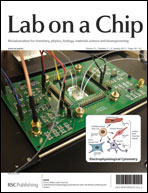High-throughput genome scanning in constant tension fluidic funnels†
Abstract
Genome Sequence Scanning (GSS) is a bacterial identification technology that detects sparse sequence-specific fluorescent tags on long DNA molecules linearized in a continuous-flow microfunnel. The efficiency and sensitivity of GSS depends on the detection throughput of well-stretched molecules. Previous studies have investigated the fundamental roles of elongational and shear flow on DNA stretching in continuous flow devices. Here, we present a novel compound funnel design that significantly improves effective molecule throughput over previously described devices. First, exploring the relationship between fluid strain rate and molecule tension allows for design of funnel geometries that accommodate high fluid velocities without compromising molecules due to overstretching under high tension. Second, a constant-strain detection channel is utilized to significantly reduce the number of molecules lost to further analysis due to shear-induced molecular tumbling and relaxation. Finally, application of the constant-strain detection channel allows for a priori prediction of spatial resolution bias due to accelerating flow. In all, the refined funnel geometries presented here yield over thirty-fold increase in effective molecule throughput due to increased fluid flow and improved retention of stretched molecules, compared to previously described devices.


 Please wait while we load your content...
Please wait while we load your content...